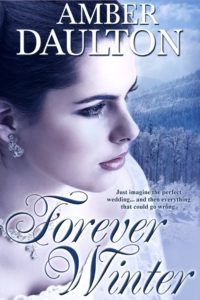 Please welcome Amber Daulton to the RAmblin’ Author Blog. She’s here to tell us a bit about undergarments worn during the Regency period in England and about her book, Forever Winter. Can’t wait to read what she has to say.
Please welcome Amber Daulton to the RAmblin’ Author Blog. She’s here to tell us a bit about undergarments worn during the Regency period in England and about her book, Forever Winter. Can’t wait to read what she has to say.
When I think of historical clothes, I see glittering gowns, large hoop shirts, and frilly corsets. Though beautiful, the clothes were a pain to wear. There were so many layers that a woman wore a good ten or twenty pounds of fabric that restricted her movement, preventing her from breathing deeply, walking fast (forget about running), and from slouching in a chair.
The Regency Era is between 1811 to 1820, but most historians recognize it between 1795 to 1837. Fashionable women wore several layers as just their unmentionables. The most common were chemises, stays and corsets, and petticoats.
A chemise, or shift, was a tight garment with short sleeves and usually made of thin white cotton and finished with an unadorned hem that was shorter than the outer dress. The neckline was fashionably low, if worn under evening wear, or high with day dresses.
A stay, or corset, topped the chemise. Stays were popular in the Georgian era, fell out of favor in the middle of the Regency, and then rose again to popularity in the Victorian age. Made from muslin, linen, or cotton, stays were typically two pieces of fabric which ladies laced together in the front and back.
During the Regency, there were two types of stays. Short stays reached just below the breasts and resembled modern-day bras, due to the popularity of high-waist gowns. Long stays extended toward the waist line but weren’t as popular as it’s shorter cousin. Some consisted of detachable straps that women removed when wearing a dress with a low, wide neckline. If non-detachable, women pushed the straps off the shoulders when needed.
Constructed from metal or bone, thick fabric, and padding, corsets pushed up the breasts and slimmed the waist into an hourglass figure with only moderate lacing. Coined in the 1830s, corsets were originally comfortable to wear, but by the Victorian era, gradually became more restricting with tighter lacing. Women inserted a busk—a hard piece of wood, metal, or bone—into the front part of the corset, usually below the breasts and over the stomach, to promote proper posture.
Petticoats added fullness to the skirts and protected the outer dress from clinging indecently to the woman’s legs. Typically, she wore one or more depending on the social engagement, how modest she wished to act, and what she could afford. A modest woman of means wore multiple petticoats while a brazen or poorer woman wore just one or none at all.
During the Regency, petticoats resembled high-waist dresses without sleeves and were made of thin cotton, silk, wool, or flannel, depending on the season and position of the woman and her family in society. Hooks and eyelets pinned the garment together in the back. Drawstrings closed the garment’s neckline around the throat for modest high-neck dresses. For low cut dresses, petticoats reached just a little over the bodice line of the stay/corset and were trimmed with lace or ruffles. Ruffles also trimmed the bottom hemline, which peeked out below the outer dress.
Chemises, corsets, and petticoats created the ideal body shape and protected the outer dresses, which were often made of thin, gossamer fabrics. The outer dresses were more expensive, so the cheaper, thicker undergarments kept the outer layers clean from the wearer’s perspiration and body odor.
So the next time you see a picture or watch a movie and Ahhhh over a woman’s gorgeous gown, remember just how uncomfortable it would be to wear all that fabric.
Thanks for reading!
 Book Blurb for Forever Winter: Viscount Camden Beckinworth had lived the life of a devil-may-care rake until his parents’ untimely death. He cast aside his personal life, returned home to save the crumbling family business and decided to re-enter Society five years later. By then, the pesky little sister of his two best childhood friends had grown into a lovely woman.
Book Blurb for Forever Winter: Viscount Camden Beckinworth had lived the life of a devil-may-care rake until his parents’ untimely death. He cast aside his personal life, returned home to save the crumbling family business and decided to re-enter Society five years later. By then, the pesky little sister of his two best childhood friends had grown into a lovely woman.
After two disastrous London seasons, Susanna Lorican accepted a marriage proposal from a neighborhood friend and, while she had adored him since childhood, she never expected the man of her dreams to reciprocate her feelings. She planned the perfect Christmas Eve wedding but she didn’t expect a snowstorm to barrel through the English countryside on the morning of.
Does social peril and uncontrollable weather keep the lovebirds from the altar or do they find their happily ever after in the midst of a disastrous wedding day?
Buy Links:
Amazon – http://amzn.to/XmHYda
Kobo – https://bit.ly/2IYOvY4
iTunes – https://apple.co/2IDeDZ6
Barnes and Noble – https://bit.ly/2LeK5dX
Books2Read – https://books2read.com/u/bwYYKO
About the Author: Amber Daulton is the author of the romantic-suspense series Arresting Onyx and several standalone novellas. Her books are published through The Wild Rose Press and Books to Go Now, and are available in ebook, print on demand, audio, and foreign language formats.
Amber lives in North Carolina with her husband and four demanding cats. Feel free to visit her at http://www.amberdaultonauthor.blogspot.com.
Social Media Links:
Facebook Author Page – www.facebook.com/amber.daulton.author
Twitter – https://twitter.com/AmberDaulton1
Street Team – https://www.facebook.com/groups/572204316296198/
Pinterest – http://pinterest.com/amberdaulton5/
Goodreads – www.goodreads.com/author/show/6624921.Amber_Daulton
Amazon Author Page – http://amzn.to/14JoZff
Instagram – https://www.instagram.com/amberdaultonauthor/
Book Bub – https://www.bookbub.com/profile/amber-daulton
Book Gorilla – https://www.bookgorilla.com/author/B00ALQITWY/amber-daulton/kcc
Smashwords – https://www.smashwords.com/profile/view/amberdaulton
LinkedIn – www.linkedin.com/pub/amber-daulton/87/538/368
Books to Go Now – http://bookstogonow.com/tb-author/amber-daulton/


Also, to let your readers know, Forever Winter is on a limited time sale. It’s only .99 cents!
Thank you so much for having me on your site.